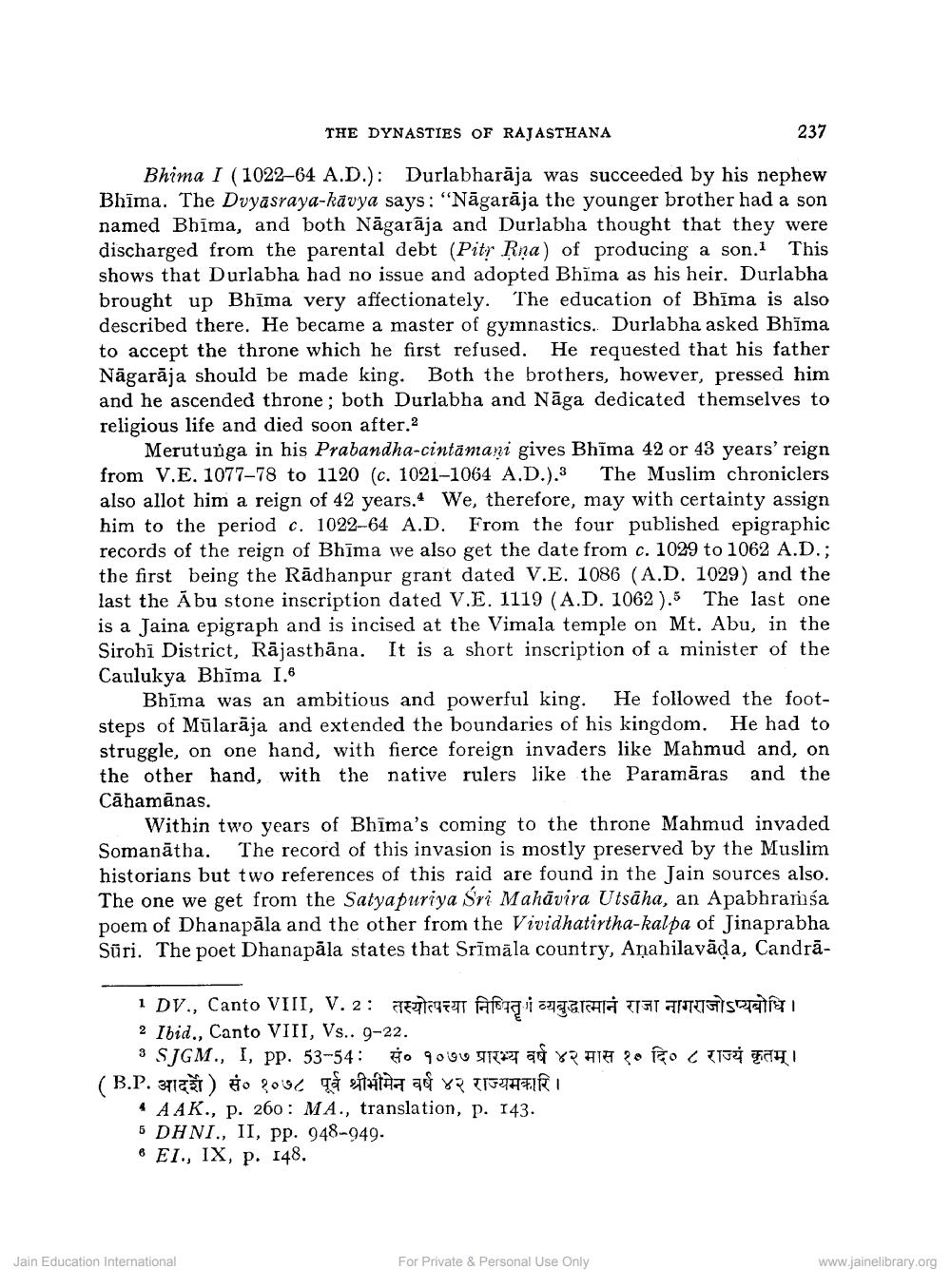________________
THE DYNASTIES OF RAJASTHANA
237
Bhima I (1022-64 A.D.): Durlabharāja was succeeded by his nephew Bhīma. The Duyasraya-kavya says: "Nāgarāja the younger brother had a son named Bhīma, and both Nāgarāja and Durlabha thought that they were discharged from the parental debt (Pitr Rna) of producing a son. This shows that Durlabha had no issue and adopted Bhima as his heir. Durlabha brought up Bhīma very affectionately. The education of Bhīma is also described there. He became a master of gymnastics. Durlabha asked Bhīma to accept the throne which he first refused. He requested that his father Nāgarāja should be made king. Both the brothers, however, pressed him and he ascended throne; both Durlabha and Nāga dedicated themselves to religious life and died soon after.2
Merutunga in his Prabandha-cintamani gives Bhīma 42 or 43 years' reign from V.E. 1077-78 to 1120 (c. 1021-1064 A.D.).3 The Muslim chroniclers also allot him a reign of 42 years. We, therefore, may with certainty assign him to the period c. 1022-64 A.D. From the four published epigraphic records of the reign of Bhīma we also get the date from c. 1029 to 1062 A.D.; the first being the Rādhanpur grant dated V.E. 1086 (A.D. 1029) and the last the Ābu stone inscription dated V.E. 1119 (A.D. 1062).5 The last one is a Jaina epigraph and is incised at the Vimala temple on Mt. Abu, in the Sirohi District, Rājasthāna. It is a short inscription of a minister of the Caulukya Bhīma 1.8
Bhima was an ambitious and powerful king. He followed the footsteps of Mūlarāja and extended the boundaries of his kingdom. He had to struggle, on one hand, with fierce foreign invaders like Mahmud and, on the other hand, with the native rulers like the Paramāras and the Cāhamānas.
Within two years of Bhīma's coming to the throne Mahmud invaded Somanātha. The record of this invasion is mostly preserved by the Muslim historians but two references of this raid are found in the Jain sources also. The one we get from the Satya puriya Sri Mahāvira Utsäha, an Apabhramsa poem of Dhanapāla and the other from the Vividhatirtha-kalpa of Jinaprabha Sūri. The poet Dhanapāla states that Srīmäla country, Anahilavāda, Candrā
1 DV., Canto VIII, V.2: TETEPTAT Tai gal ST ANTISTATI 2 Ibid., Canto VIII, Vs.. 9-22.
3 SJGM., I, pp. 53-54: 80 909091227 XA1H 30 FOC 1150 F741 (B.P. 313) 8o 2006 et staitaa au XP T HEIR
4 A AK., p. 260: MA., translation, p. 143. 5 DHNI., II, pp. 948-949. & EI., IX, p. 148.
Jain Education International
For Private & Personal Use Only
www.jainelibrary.org




